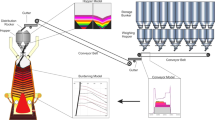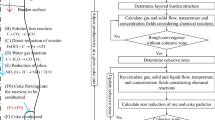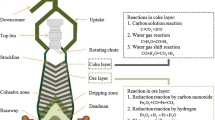Abstract
The burden distribution in the ironmaking blast furnace plays an important role for the operation as it affects the gas flow distribution, heat and mass transfer, and chemical reactions in the shaft. This work studies certain aspects of burden distribution by small-scale experiments and numerical simulation by the discrete element method (DEM). Particular attention is focused on the complex layer-formation process and the problems associated with estimating the burden layer distribution by burden profile measurements. The formation of mixed layers is studied, and a computational method for estimating the extent of the mixed layer, as well as its voidage, is proposed and applied on the results of the DEM simulations. In studying a charging program and its resulting burden distribution, the mixed layers of coke and pellets were found to show lower voidage than the individual burden layers. The dynamic evolution of the mixed layer during the charging process is also analyzed. The results of the study can be used to gain deeper insight into the complex charging process of the blast furnace, which is useful in the design of new charging programs and for mathematical models that do not consider the full behavior of the particles in the burden layers.

















Similar content being viewed by others
References
Kajiwara Y, Jimbo T, Kometani A, Shimoda Y (1984) Application of simulation model for burden distribution to actual operations. Trans ISIJ 24:379–386
Chen J, Akiyama T, Yagi JI (1992) Effect of burden distribution pattern on gas flow in a packed bed. ISIJ Int 32(12):1259–1267
Radhakrishnan VR, Ram KM (2001) Mathematical model for predictive control of the bell-less top charging system of a blast furnace. J Process Control 11:565–586
Gupta PK, Rao AS, Sekhar VR, Ranjan M, Naha TK (2010) Burden distribution control and its optimisation under high pellet operation. Ironmak Steelmak 37:235–239
Park JI, Jung JH, Jo MK, Oh HS, Han JW (2011) Mathematical modelling of the burden distribution in the blast furnace shaft. Met Mater Int 17(3):485–496
Fan Z, Natsui S, Ueda S, Yang T, Kano J, Inoue R, Ariyama T (2010) Transient behavior of burden descending and influence of cohesive zone shape on solid flow and stress distribution in blast furnace by discrete element method. ISIJ Int 50(7):946–953
Hattori M, Iino B, Shimomura A, Tsukiji H, Ariyama T (1993) Development of burden distribution simulation model for bell-less top in a large blast furnace and its application. ISIJ Int 33:1070–1077
Mitra T, Saxén H (2014) Model for fast evaluation of charging programs in the blast furnace. Metall Mater Trans B 45(6):2382–2394
Zhu Q, Lu C, Yin Y, Chen X (2013) Burden distribution calculation of bell-less top of blast furnace based on multi-radar data. J Iron Steel Res Int 20(6):33–37
Nag S, Koranne VM (2009) Development of material trajectory simulation model for blast furnace compact bell-less top. Ironmak Steelmak 36(5):371–378
Hinnelä J, Saxén H (2001) Neural network model of burden layer formation dynamics in the blast furnace. ISIJ Int 41(2):142–150
Saxén H, Hinnelä J (2004) Model for burden distribution tracking in the blast furnace. Miner Process Extr Metall 25:1–27
Mio H, Komatsuki S, Akashi M, Shimosaka A, Shirakawa Y, Hidaka J, Kadowaki M, Matsuzaki S, Kunitomo K (2008) Validation of particle size segregation of sintered ore during flowing through laboratory-scale chute by discrete element method. ISIJ Int 48(12):1696–1703
Yu Y, Saxén H (2010) Experimental and DEM study of segregation of ternary size particles in a blast furnace top bunker model. Chem Eng Sci 65(18):5237–5250
Wu SL, Kou MY, Xu J, Guo XY, Du KP, Shen W, Sun J (2013) DEM simulation of particle size segregation behavior during charging into and discharging from a Paul-Wurth type hopper. Chem Eng Sci 99:314–323
Ho CK, Wu SM, Zhu HP, Yu AB, Tsai ST (2009) Experimental and numerical investigations of gouge formation related to blast furnace burden distribution. Miner Eng 22:986–994
Ichida M, Takao M, Morizane Y, Nakayama T, Anan K, Kakiuchi K, Yamada I (2006) Inner profile and burden descent behavior in the blast furnace. Nippon Steel Technical Report No. 94, pp 80–86
Yu Y, Westerlund A, Paananen T, Saxén H (2011) Inter-particle percolation segregation during burden descent in the blast furnace. ISIJ Int 51(7):1050–1056
Song Q (2013) Effect of nut coke on the performance of the ironmaking blast furnace. PhD Thesis, Delft University of Technology
Yu Y, Saxén H (2013) Particle flow and behavior at bell-less charging of the blast furnace. Steel Res Int 84(10):1018–1033
Cundall PA, Strack ODL (1979) A discrete numerical model for granular assemblies. Geotechnique 29:47–65
Yu Y, Saxén H (2012) Effect of DEM parameters on the simulated inter-particle percolation of pellets into coke during burden descent in the blast furnace. ISIJ Int 52(5):788–796
Delaney GW, Cleary PW, Hilden M, Morrison RD (2012) Testing the validity of the spherical DEM model in simulating real granular screening processes. Chem Eng Sci 68:215–226
Matsumoto M, Nishimura T (1998) Mersenne twister: a 623-dimensionally equidistributed uniform pseudo-random number generator. ACM Trans Model Comput Syst 8(1):3–30
Propster M, Szekely J (1977) The porosity of systems consisting of layers of different particles. Powder Technnol 17(1):123–138
Liu J, Xue Q, She X, Wang J (2013) Investigation on interface resistance between alternating layers in the upper of blast furnace. Powder Technol 246:73–81
Wu S, Fu C, Liu C, Xu J, Kou M (2011) Coke collapse model and collapse profile variation law for bell-less top BF. J Iron Steel Res Int 18(10):8–12
Matsui Y, Shibata K, Ono R (2005) The principle of blast furnace operational technology and centralized gas flow by center coke charging. Kobelco Technol Rev 26:12–20
Fu D, Chen Y, Zhou CQ (2015) Mathematical modeling of blast furnace burden distribution with non-uniform descending speed. Appl Math Model. doi:10.1016/j.apm.2015.02.054
Acknowledgments
The Graduate School in Chemical Engineering, Tekes and participating industry in the SIMP program coordinated by FIMECC Ltd. are acknowledged for financial support. The discrete element method simulations and analysis were conducted using the EDEM software provided by DEM Solutions Ltd., Edinburgh, Scotland.
Author information
Authors and Affiliations
Corresponding author
Rights and permissions
About this article
Cite this article
Mitra, T., Saxén, H. Discrete element simulation of charging and mixed layer formation in the ironmaking blast furnace. Comp. Part. Mech. 3, 541–555 (2016). https://doi.org/10.1007/s40571-015-0084-1
Received:
Revised:
Accepted:
Published:
Issue Date:
DOI: https://doi.org/10.1007/s40571-015-0084-1




